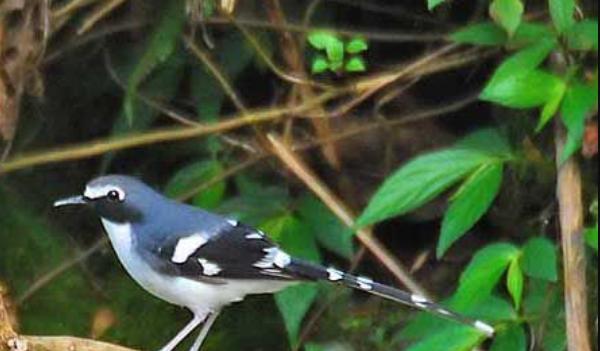Grey-backed swallowtail (scientific name: Enicurus schistaceus) is a black-and-white swallowtail with a body length of 23 cm, and the adult gray-backed swallowtail is black: the frontal, eye, cheek, and neck sides are black; the forehead is white above the eye circles; the top of the head to the back is blue-gray; the waist and tail coverts are white; the flight feathers are black, the large covert feathers, the middle covert feathers are the first end, the base of the primary flying feathers and the secondary flying feathers are white, forming a distinct white wing spot, and the secondary flight feathers have narrow white end spots; the tail feather ladder is forked and black. Its base and end are white, the outermost two pairs of tail feathers are pure white, the chin to the upper throat is black, and the rest of the lower body is pure white. The iris is black brown; the mouth is black; and the flesh of the tarsus, toes, and claws is white.

Distribution in China Is Found in Southern Hunan, Eastern and Northwestern Fujian, Northern and Southern Guangdong, Yaoshan, Guangxi, Sichuan (Western Kangding, Central Guanxian, Ya'an, Emei), Yunnan (Western, Southern, Southeastern) and Guizhou.
It generally inhabits altitudes between 340 and 1600 meters above sea level, and often rests on rocks at the water's edge or on stones in rapids, and appears next to mountain streams. Often alone or in pairs. Usually rest at the water's edge or on stones in the water, or forage in shallow water. Feeds on aquatic insects, ants, dragonfly larvae, caterpillars, snails, etc.
The breeding season is from April to June. Nests usually nest in rock crevices along the rapidly flowing mountain streams in the forest, and the nests are well hidden and not easy to find. The nest is disc-shaped or cup-shaped, mainly woven from moss and whisker roots, with fine grass stems and dead leaves. The cave is covered with protruding natural rocks and is surrounded by ferns and grasses that hide the nest. Eggs are laid as soon as the nest is built, with 3-4 eggs laid per clutch. The eggs are ovoid, stained white, and covered with reddish-brown spots. The incubation of the eggs is carried out by the female bird to assume the late growth of the chicks, and on the day after the hatching, the female and male parent birds begin to search for food and feed the chicks. Females feed significantly more often than males. At night, the female sleeps with the chicks in the nest, while the male perches in a nearby tree.